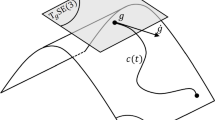Abstract
A general mathematical formulation of the n × n proper orthogonal matrix, that corresponds to a rigid rotation in n-dimensional real Euclidean space, is given here. It is shown that a rigid rotation depends on an angle (principal angle) and on a set of (n ‒ 2) principal axes. The latter, however, can be more conveniently replaced by only two orthogonal directions that identify the plane of rotation. The inverse problem, that is, how to compute these principal rotation parameters from the rotation matrix, is also treated. In this paper, the Euler Theorem is extended to rotations in n-dimensional spaces by a constructive proof that establishes the relationship between orientation of the displaced orthogonal axes in n dimensions and a minimum sequence of rigid rotations. This fundamental relationship, which introduces a new decomposition for proper orthogonal matrices (those identifying an orientation), can be expressed either by a product or a sum of the same rotation matrices. A similar decomposition in terms of the skew-symmetric matrices is also given. The extension of the rigid rotation formulation to n-dimensional complex Euclidean spaces, is also provided. Finally, we introduce the Ortho-Skew real matrices, which are simultaneously proper orthogonal and skew-symmetric and which exist in even dimensional spaces only, and the Ortho-Skew-Hermitian complex matrices which are orthogonal and Skew-Hermitian. The Ortho-Skew and the Ortho-Skew-Hermitian matrices represent the extension of the scalar imaginary to the matrix field.
Similar content being viewed by others
References
RODRIGUEZ, M.O. “Des Lois Geometriques Qui Régissent les Déplacement d’un Système Solide dans L’espace, et de la Variation des Coordonnées Provenant de ces Déplacements Considéréd Independamment des Causes qui Peuvent les Produire, “ Journal de Mathématique Pures et Appliquées (Liouville), 5 (1840), pp. 380–440.
CAYLEY, A. “On the Motion of Rotation of a Solid Body, “ Cambridge Mathematical Journal, III (1843), pp. 224–232. Also in The Collected Mathematical Papers of Arthur Cayley, I. Cambridge, MA: The Cambridge University Press, 1889. Reprinted by Johnson Reprint Corp., New York, 1963, pp. 28–35.
CAYLEY, A. “On Certain Results Relating to Quaternions, “ Cambridge Mathematical Journal, III (1843), pp. 131–145. Also in The Collected Mathematical Papers of Arthur Cayley, I. Cambridge, MA: The Cambridge University Press, 1889. Reprinted by Johnson Reprint Corp., New York, 1963, pp. 123–126.
EULER, L. “Formulae Generales pro Trandlatione Quacunque Corporum Rigidorum, “ Novi Acad. Sci Petrop., 20 (1775), pp. 189–207.
ARCIDIACONO, G. “Relatività e Cosmologia, “ Vol. I: Le Teorie Relativistiche di Einstein, Libreria Eredi Virgilio Veschi, Roma, 1979, pp. 24–43 and pp. 54–59.
FANTAPPIÉ, L. “Su una Nuova Teoria di Relatività Finale, “ Rend. Acc. Lincei, Ser. 8, Vol. 17, Fasc. 5 (1954).
CARTAN, E. “Leçons sur la Théorie des Spineurs, “ Vol. I, Actualité Scientifiques, n. 643, Paris, Hermann, 1938.
ARCIDIACONO, G. “Relatività e Cosmologia, “ Vol. II: Teoria dei Gruppi e Modelli di Universo, Libreria Eredi Virgilio Veschi, Roma, 1979, pp. 11–21.
ABRAHAM, R., MARSDEN, J. E., and RATIU, T. Manifolds, Tensor Analysis, and Applications, Springer Verlag, Applied Math Sciences No. 75., 1983, Addison Wesley.
LOVELOCK, D. and RUND, H. Tensors, Differential Forms, and Variational Principles, Dover Publications, pp. 131–136, 1989.
ARCIDIACONO, G. “Sui Gruppi Ortogonali negli Spazi a Tre, Quattro, Cinque Dimensioni, “ Portugaliae Mathematica, Vol. 14, Fasc. 2, 1955.
ARCIDIACONO, G. “Sulle Trasformazioni Finite dei Gruppi delle Rotazioni, “ Coll. Math. XV, 1963, pp. 259–271.
FANTAPPIÉ, L. “Sulle Funzioni di una Matrice, “ Anais da Academia Brasileira de Ciências, N. 1, 26 (1954).
BAR-ITZHACK, I.Y. “Extension of Euler’s Theorem to n-Dimensional Spaces, “ IEEE Transactions on Aerospace and Electronic Systems, T-AES/25/6//30692, Vol. 25, No. 6, November 1989, pp. 439–517.
SHUSTER, M. D. “A Survey of Attitude Representations, “ Journal of the Astronautical Sciences, Vol. 41, No. 4, October-December 1993, pp. 439–517.
MORTARI, D. “ESOQ: A Closed-Form Solution to the Wahba Problem, “ Journal of the Astronautical Sciences, Vol. 45, No. 2, April-June 1997, pp. 195–204.
MORTARI, D. “n-Dimensional Cross Product and Its Application to Matrix Eigenanalysis, “ Journal of Guidance, Control, and Dynamics, Vol. 20, No. 3, May-June 1997, pp. 509–515.
Author information
Authors and Affiliations
Corresponding author
Rights and permissions
About this article
Cite this article
Mortari, D. On the Rigid Rotation Concept in n-Dimensional Spaces. J of Astronaut Sci 49, 401–420 (2001). https://doi.org/10.1007/BF03546230
Published:
Issue Date:
DOI: https://doi.org/10.1007/BF03546230




